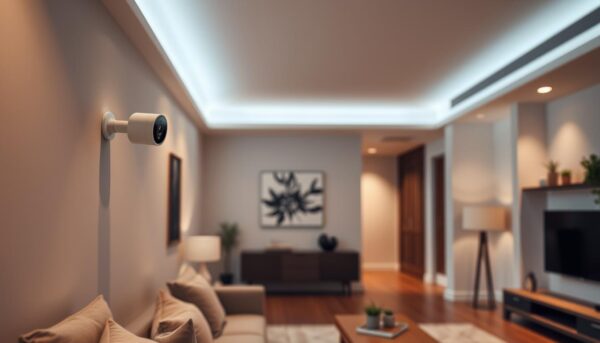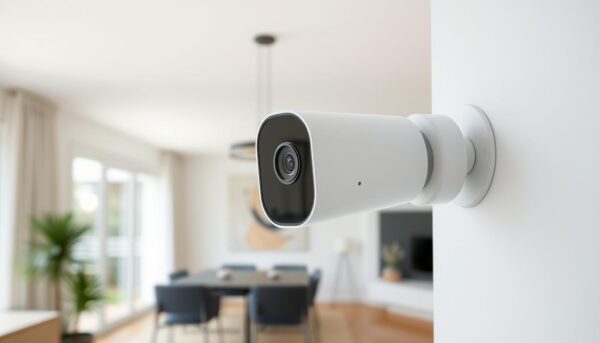✅ Last checked on
What if your security system could protect your privacy and adapt to your lifestyle without relying on the cloud? Imagine controlling every angle of your property while keeping sensitive data entirely under your roof. This isn’t just possible—it’s simpler than you think.
Cloud-free smart cameras empower you to build a surveillance setup that prioritizes security and customization. By bypassing third-party servers, you eliminate vulnerabilities tied to external storage. Instead, footage stays local, accessible only through your private network.
These devices integrate seamlessly with platforms like Home Assistant, acting as building blocks for advanced automation. Whether adjusting a camera’s pan-tilt-zoom controls or triggering lights based on motion detection, every feature operates offline. Stream live video with near-zero latency using preloaded protocols, or activate recording only when specific conditions are met.
This guide dives into technical specs, setup workflows, and creative ways to maximize autonomy. You’ll learn how to define camera states, execute commands like play_stream, and configure fail-safes for uninterrupted monitoring. Ready to reclaim control?
Key Takeaways
- Cloud-free cameras keep video data local, reducing exposure to breaches.
- Integration with automation platforms enables advanced offline triggers and routines.
- Preconfigured streaming options minimize lag for real-time monitoring.
- Motion detection settings can sync with other smart devices for layered security.
- Local storage eliminates monthly fees and ensures 24/7 access without internet reliance.
Introduction to Home Assistant and Cloud-Free Smart Camera Solutions
Smart homes thrive when devices communicate without third-party interference. Open-source platforms like Home Assistant bridge this gap, letting you orchestrate lights, locks, and surveillance tools through one interface. No subscriptions. No data leaks.

Understanding the Home Assistant Platform
This free automation hub runs on local servers, accessible via web browsers or mobile apps. It supports 1,000+ devices, from thermostats to video doorbells. Customize actions using YAML scripts or prebuilt templates. Want your porch light to activate when motion is detected? Done.
Benefits of Cloud-Free Video Streaming and Data Security
Storing footage locally cuts latency and shields recordings from hackers. Preconfigured stream protocols like RTSP deliver crisp video without buffering. For example, Reolink models sync natively with Home Assistant, offering 4K resolution and encrypted storage.
| Feature | Cloud-Based Systems | Local Setup |
|---|---|---|
| Data Access | Third-party servers | Your network only |
| Monthly Fees | $5-$40 | $0 |
| Latency | 1-3 seconds | <0.5 seconds |
Automation routines add layers of security. Pair motion alerts with smart locks or sirens using community-driven setup guides. Night vision? Audio alerts? Adjust settings in real time without touching physical hardware.
Exploring home assistant compatible cameras and Their Key Functionalities
Modern surveillance systems unlock new possibilities when every component serves multiple roles. Devices designed for open-source platforms act as modular tools, letting you create custom security workflows tailored to your needs.

Integration as a Building Block for Home Automation
These systems use standardized protocols like ONVIF to connect with other smart devices. For example, enabling motion detection triggers porch lights via enable_motion_detection commands. This transforms cameras into sensors that activate routines based on real-time events.
Streaming, Recording, and Motion Detection Capabilities
High-definition streams minimize pixelation during critical moments. RTSP feeds deliver 4K video with under 0.2s latency. Local recording options let you save clips to NAS drives or microSD cards without cloud dependencies.
| Action | Function | Use Case |
|---|---|---|
| play_stream | Live viewing | Real-time monitoring |
| snapshot | Instant image capture | Evidence collection |
| disable_motion | Reduce false alerts | Quiet hours |
Overview of Actions: Enabling and Disabling Key Features
Camera states like idle or recording determine resource usage. Use record commands during specific hours to conserve storage. Pan-tilt-zoom controls integrate with motion tracking, automatically adjusting angles to follow activity.
Advanced settings allow conditional triggers. If a camera enters unavailable state, backup devices activate. This layered approach ensures uninterrupted coverage while maximizing your system’s potential.
Setting Up and Optimizing Your Smart Camera Integration
Secure your surveillance system in three phases: hardware setup, protocol configuration, and automation design. Start by positioning your Reolink device where it captures critical zones. Ensure stable Wi-Fi or wired connections before proceeding.
Step-by-Step Instructions for Device Setup
- Install the Reolink app and create a local admin account (avoid cloud logins).
- Scan the camera’s QR code or manually enter its UID in the app’s “Add Device” menu.
- Assign a static IP address to prevent network conflicts during integration.
Configuring Camera Settings and Stream Options
Enable RTSP/ONVIF under “Network > Advanced Settings.” Use these credentials in your automation platform:
| Protocol | Use Case | Latency |
|---|---|---|
| RTSP | High-resolution streaming | 0.2s |
| ONVIF | Motion alerts & PTZ controls | 0.3s |
Activate “Preload Stream” in Home Assistant’s developer tools to buffer video feeds. Monitor CPU usage—disable this feature if system resources drop below 20%.
“Testing snapshots during setup helped me identify blind spots before finalizing angles.”
Create automations using YAML scripts. For example:
- alias: Night Mode Recording
trigger: sunset
action:
service: camera.enable_motion_detection
target: entity_id: camera.backyardIf streams fail, check firewall rules for ports 554 (RTSP) and 8000 (ONVIF). Reset credentials if authentication errors persist.
Conclusion
Your surveillance setup deserves full control without compromising speed or security. Cloud-free systems ensure recordings stay offline, shielded from external breaches. With Home Assistant, you unify devices into a responsive network that adapts to your routines.
These integrations excel at real-time responses. Motion detection triggers lights or locks instantly, while local streaming eliminates lag during critical moments. Reolink models, praised in user reviews for their reliability, demonstrate how certified devices deliver crisp 4K feeds and encrypted storage.
Ready to upgrade? Follow our setup guide to optimize angles and automation rules. Test snapshots first to verify coverage zones, then activate fail-safes like backup recording during network outages.
This approach transforms ordinary monitoring into an intelligent defense layer. You gain 24/7 access to footage, zero monthly fees, and total command over privacy settings. Start redefining your security today—every adjustment brings you closer to a truly autonomous smart ecosystem.